
* The Mach 3 Lockheed A-12 reconnaissance aircraft was a massive leap forward in aircraft design, demanding the invention of a wide range of new technologies. It took a long time to get it to work right, but it did eventually prove its value. However, its operational career was brief, being quickly replaced by the Air Force's derivative, the SR-71. The A-12 also spawned an interceptor derivative, the YF-12A, that never went into production.
* In the mid-1950s, the US Central Intelligence Agency (CIA) obtained a high-altitude jet reconnaissance aircraft, the Lockheed "U-2", developed by Clarence "Kelly" Johnson and his team at the supersecret Lockheed "Skunk Works". The U-2 conducted overflights of the USSR from 4 July 1956 to 1 May 1960, when one was finally shot down, leading to a noisy international crisis.
It had been realized from the outset of the U-2 program that Soviet defenses would eventually be able to deal with the U-2, and indeed the CIA had known they were pushing their luck with the final mission over the USSR. In fact, the agency had been working towards a successor to the U-2 for several years. In August 1957, the Scientific Engineering Institute (SEI) -- essentially a "CIA subsidiary", based in the Boston area -- was assigned to investigate solutions to the problem. SEI's conclusion was that an aircraft with a reduced "radar cross-section (RCS)", or a "stealthy" aircraft in modern terms, would have much better chances of survival. Further work added that high speed and altitude would make interception even more difficult.
Lockheed and the Convair Division of General Dynamics were asked to submit proposals. Lockheed's Skunk Works came up with a series of diverse "Archangel (A)" concepts -- the U-2 had been called "Angel" by the Skunk Works crew -- while Convair proposed a vehicle codenamed FISH, which would be launched from a modified Convair B-58 supersonic bomber. By the end of 1958, the basic concepts had been judged feasible, and work on more detailed development went forward under Project GUSTO.
By August 1959, the concepts had evolved to the Lockheed "A-11" and the Convair KINGFISH. Both had similar performance -- over Mach 3 -- and range, but the A-11 seemed to have the edge in reduced RCS. The A-11 was selected over the KINGFISH proposal, though Lockheed was required to provide more proof that the A-12 would really have the low RCS claimed for it. Lockheed was able to back up the claims, and a contract was awarded for twelve aircraft in February 1960.
Some changes were requested, with the design then becoming the "A-12". The project was codenamed OXCART; apparently the name was chosen at random as a security measure, but Kelly Johnson said it was appropriate because the aircraft would be "so slow". The Eisenhower Administration was not highly enthusiastic about the A-12, however, with the project funded mostly as a technology development exercise. Various models were tested in the wind tunnel at the US National Aeronautics & Space Administration's (NASA) Ames center in California, before proceeding to a build configuration.
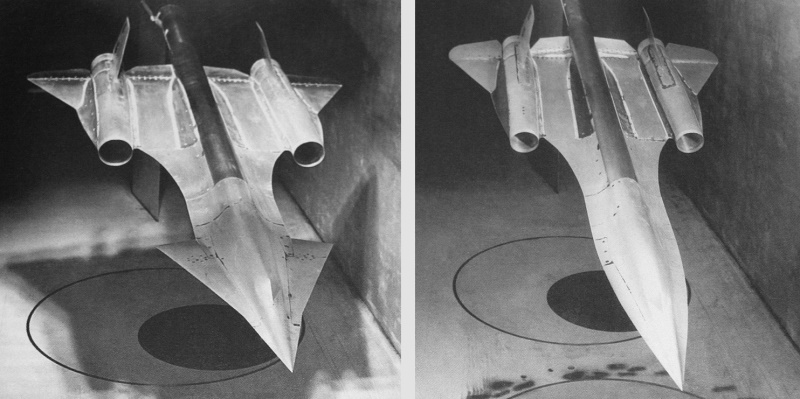
* As it emerged, the A-12 was a sleek black dagger of an aircraft, powered by two advanced Pratt & Whitney (P&W) "JT11D-20" engines, military designation "J58". The first flight of the A-12 took place from the top-secret Area 51 in Nevada on 26 April 1962 -- a year behind schedule, building the machine having proven troublesome -- with Lockheed test pilot Lou Schalk at the controls. The "official" first flight was on 30 April.
The initial flights, which followed taxi tests and brief hops, were of course shakedown tests, and well subsonic. The A-12 broke Mach 1 on 4 May; by the end of 1962, the A-12 had demonstrated the ability to fly at Mach 2.2 at an altitude of 18,300 meters (60,000 feet). By that time, four prototypes were on hand, including a two-seat trainer, nicknamed the "Titanium Goose" presumably for its long neck / rear wing configuration. The trainer was, at least informally, designated "TA-12". Kelly Johnson was given a ride in it -- he had a right.
However, the program was not making satisfactory progress, the critical path being the J58; P&W was having problems getting the engine to fly right. One nasty problem that took time to fix was the tendency of airflow to reverse back out the front of the intake under high-speed flight -- causing the affected engine to "unstart" with a very loud BANG! Unstarts were compared to "running into a brick wall", or going off a freeway in a car and hitting a guard rail. One pilot got knocked into a daze when he hit his head during an unstart -- but the engine restarted on its own, and he made it back down to the ground in one piece.
In late May 1963, a faulty airspeed indicator on an A-12 led to loss of control by the pilot, Ken Collins. The aircraft fell to earth south of Wendover, Utah, with Collins ejecting unharmed. Local witnesses were sworn to secrecy; the area was sealed off, and those poking around were told that the crashed aircraft had been carrying nuclear weapons, in order to encourage them to go away. The press was told that a Republic F-105 strike fighter had crashed. The A-12s were grounded for a week while the bug was fixed. On 20 July 1963, an OXCART punched through Mach 3 for the first time. Over the next year, the aircraft would reach even higher speeds at extreme altitudes.
* Problems persisted with the A-12 program. By September 1966, the OXCART had not performed an operational mission; the machine was just too much of a step forward, Kelly Johnson saying: "Everything had to be invented. Everything." The A-12 was over schedule and budget, and becoming something of an embarrassment to the CIA.
Difficulties with the J58s continued. They tended to stall and cause the aircraft to vibrate violently, with crews sometimes forced to bail out. One was killed when his parachute didn't open, and other test pilots, spooked, left the program. CIA management wanted Lockheed to add an electronic engine control system, but Kelly Johnson didn't trust electronics -- his mindset was still stuck in the 1950s, when avionics systems were based on vacuum tubes and were notoriously unreliable. The CIA insisted, saying the program would be canceled unless it were done.
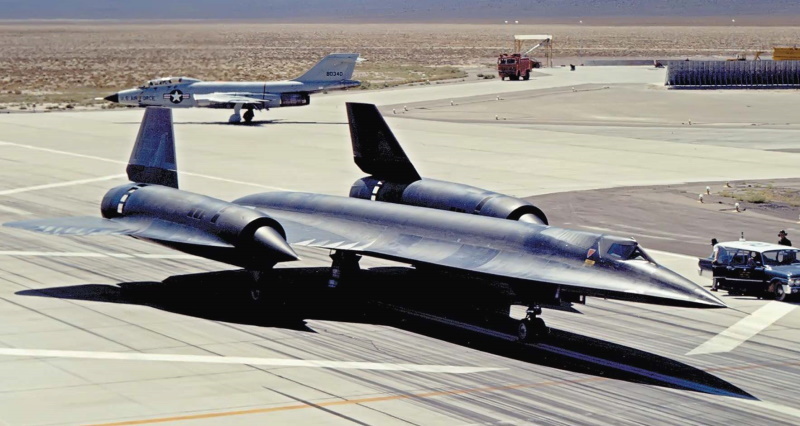
The problems were mostly resolved, though the J58 would always be a finicky beast. An A-12 performed its very first long-range high-speed flight on 27 January 1965. The flight lasted 1 hour 40 minutes, with 1 hour 15 minutes of that flight above Mach 3.1. The range of the flight was 4,775 kilometers (2,580 NMI), cruising at altitudes from 23,100 to 24,400 meters (75,800 to 80,000 feet). The OXCART seemed to be ready to go, and there were plans to perform missions over Southeast Asia; unfortunately, sustained high-speed flight led to the discovery of still more problems that had to be resolved.
These troubles were resolved in turn, but then politics intervened. Missions over Southeast Asia were to be flown out of Kadena Air Base on Okinawa. The politicians, all the way up to President Lyndon Baines Johnson, thought that performing such missions from Kadena would cause embarrassment for the Japanese government, and so the plans were vetoed. The A-12 was nonetheless ready to go the instant the people in charge gave the word. It had, by that time, informally acquired a name: "Cygnus", following the Lockheed inclination to name aircraft after astronomical entities: "Shooting Star", "Constellation", "Starfighter".
BACK_TO_TOP* A total of 15 A-12s was built -- including the trainer, plus two "M-21" drone carriers, discussed later. Final delivery was in 1964. The A-12, in maturity, was a breathtaking machine; a long black dart, with a rear-mounted delta wing and long leading-edge wingroot extensions, called "chines", running up to the nose. The airframe was an early manifestation of "wing-body blending"; it was difficult to tell where the fuselage left off and the wing began. Early concepts had featured nose canard wings, but the chines proved so effective as to render them unnecessary.
The smooth curves also helped scatter radar beams and reduce RCS; in addition, the wing leading edge featured pyramidal "traps" under the skin that broke up radar reflections. The A-12 was a pioneer in the development of aircraft stealth technology -- indeed, it was a pioneer up and down the line, demanding innovation in nearly all of its subsystems. The Pratt & Whitney J58 turbojet engines were a particularly significant example. One was mounted on each wing in mid-span, with each having a dry thrust of 91 kN (9,300 kgp / 20,500 lbf), and afterburning of 145 kN (14,740 kgp / 32,500 lbf).
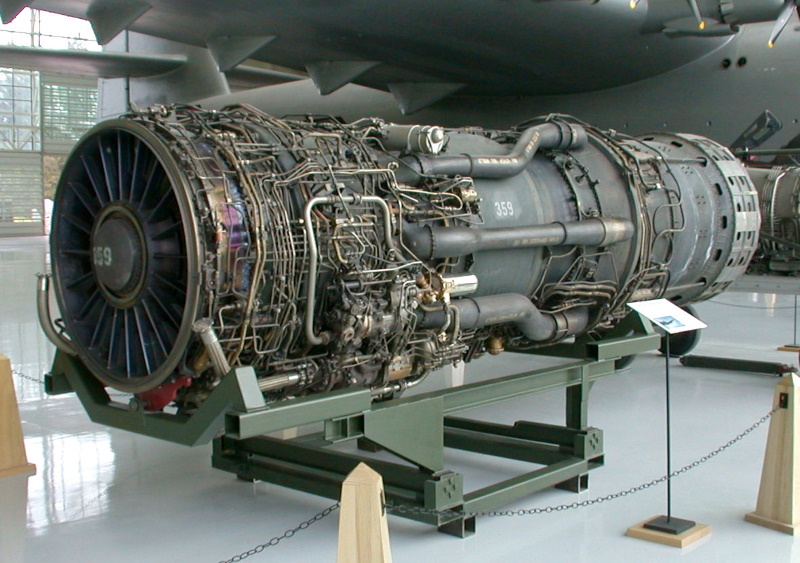
The J58s featured a prominent intake bullet that could be moved to divert airflow around the engine spool system to flow directly into the afterburner, with the engine then operating as a ramjet-like "ramburner". The inlet movement controls were automated, to reduce the chances of unstarts. Maximum thrust was over 14.24 kN (14,500 kgp / 32,000 lbf). The engine was made most from a high-temperature nickel alloy named "Waspalloy" that was heavy and very hard to work, with some critical parts made of titanium. There were arrays of secondary inlets on the engine nacelles that opened to provide airflow on the runway and at low speeds. Engine starting was by ground air cart.
The runways had to be kept very clean, because the low-slung engines inhaled huge volumes of air and tended to pick up debris along with it. The first five machines delivered, including the two-seat trainer, were fitted with afterburning P&W J75 engines, the J58 not being ready for flight service at the time. All except the trainer would be upgraded to J58s. No other aircraft, except the A-12's siblings, would be fitted with the J58.
The fuselage, rear of a mid-air boom refueling receptacle on the spine, was filled with a complex of six integral fuel tanks. Fuel management was a bit tricky; balance had to be maintained, since the A-12 was touchy along the pitch axis. Total fuel capacity was 37,040 liters (9,785 US gallons) of JP-7, a special low-volatility fuel that hard to ignite: toss a lit cigarette into a bucket of JP-7, the cigarette would go out.
The A-12 was so full of fuel tanks that it had to take off with a partial fuel load, then top off from a KC-135Q tanker in the air -- its flight weight could be more than its maximum take-off weight. The KC-135s featured separate tanks for the JP-7 fuel. The A-12's tanks were pressurized with nitrogen, both to reduce fire hazard, and to make sure that emptied tanks didn't collapse when the aircraft returned from high altitude.
Flight control surfaces included "elevons" -- elevator-ailerons, the two being effectively the same in a delta-wing aircraft -- inboard and outboard of the engines; plus all-moving tailfins, one on top of the rear of each engine, canted inward by 15 degrees. The nose landing gear had twin wheels, and retracted forward; each main gear had three wheels, and retracted inward from the wings toward the fuselage. A drag chute, deployed from a hatch on the spine of the aircraft between the wings, helped reduce landing roll. The flight control surfaces and landing gear were hydraulically actuated.
_____________________________________________________________________
LOCKHEED A-12 CYGNUS:
_____________________________________________________________________
wingspan:
16.94 meters (55 feet 7 inches)
wing area:
166.8 sq_meters (1,795 sq_feet)
length:
30.96 meters (101 feet 7 inches)
height:
5.64 meters (18 feet 6 inches)
empty weight:
24,000 kilograms (52,000 pounds)
MTO weight:
53,070 kilograms (117,000 pounds)
maximum speed:
3,555 KPH (2,210 MPH / 1,920 KT)
service ceiling:
> 25,900 meters (> 85,000 feet
range:
4,360 kilometers (2,875 miles / 2,500 NMI)
_____________________________________________________________________
The pilot sat on an ejection seat under a clamshell canopy that hinged open from the rear. The ejection seat was originally the Lockheed-made rocket-boosted "C-2", updated to the improved "SR-1" -- later redesignated "F-1" -- which would be standard for the A-12 and its successors. The cockpit windows were made of thick quartz glass, bonded to the window frames by high-frequency sound waves.
Cabin pressure could be set to 3,050 meters (10,000 feet) or 7,925 meters (26,000 feet). In theory, the pilot could get by with a standard flight suit and oxygen mask, but a full pressure suit was normal worn -- originally the Dave Clark S-901, leading to improved versions. Incidentally, there were little "vanity mirrors" in the cockpit on the windscreen frame, meant to allow the pilot to check to see if anything was wrong with the suit.
For the most part, there was nothing particularly sophisticated about aircraft avionics, which included radios, identification friend or foe transponder, radio navaids / landing aids, and a flight recorder. It seems the A-12 would eventually acquire defensive warning systems. Attempting to read altitude and speed with conventional aircraft instrumentation was unworkable at Mach 3, so Honeywell developed an "air data computer" that could give proper readings.
Another unusual instrumentation feature was a "driftsight" in the center of the dashboard, a scheme inherited from the U-2, for navigation. The driftsight was a purely optical system, which displayed the magnified image from the periscope on the bottom of the fuselage, allowing the pilot to observe the ground track and check for cloud cover. The U-2 could switch the driftsight to a dome on the nose to permit the pilot to perform celestial navigation, but the A-12 had a sophisticated "astro-inertial navigation system (AINS)" that could perform celestial navigation on its own. There was also a backup INS. Reconnaissance gear would be carried in a compartment behind the cockpit, called the "Q-bay".
Since the A-12 would encounter high friction heating at operational speeds, the airframe was designed to stand the heat. Much of the airframe was made of titanium alloys, titanium then being something of a "new metal" that offered high temperature resistance and strength-to-weight ratios, though its handling in manufacture was very tricky -- it had to be welded in an inert-gas atmosphere, and water used to wash welded parts had to be distilled, since the welds were very touchy about chlorine used to purify the Burbank water supply. When bolts started falling out in testing, the problem turned out to be due to traces of cadmium left by tools; tools with cadmium plating were then banished from the production facility. Ironically, the titanium ore was obtained from the Soviet Union, working through front companies.
The airframe of course expanded and contracted considerably during high-speed flight, and trying to deal with the shifting dimensions was troublesome -- the A-12 and its successors oozed fuel on the runway normally, with the dripping turning into a drizzle when the fuel tanks were pressurized. The leaks stopped once the aircraft got up to speed. Ground crews tended to be stained with the smelly fuel, which could cause rashes, but they found out it would wash out easily if a can of cola was added to the wash load.
Large titanium panels had corrugations running their length, which minimized the warping of the panels due to heating. Although most of the airframe was titanium, large sections of the wing leading and trailing edges, tailfins, chines, and inlet spikes were made of a heat-resistant composite material featuring, among other things, asbestos and fiberglass. The composite reduced the RCS.
The aircraft's tires were impregnated with aluminum powder for heat tolerance, and filled with nitrogen to reduce fire hazard. The fuselage wheel wells were given a degree of cooling by being surrounded with fuel tanks. Igniting the nonvolatile JP-7 required use of a fiery igniter fluid, known as "tri-ethyl borane (TEB)", carried in a small tank that was pressurized with nitrogen to prevent the TEB from lighting up spontaneously. The engine oil could perform at up to 345 degrees Celsius (650 degrees Fahrenheit); it had to be heated before take-off to ensure it was fluid, being "thick as molasses" in its normal state. The hydraulic fluid could also tolerate high temperatures.
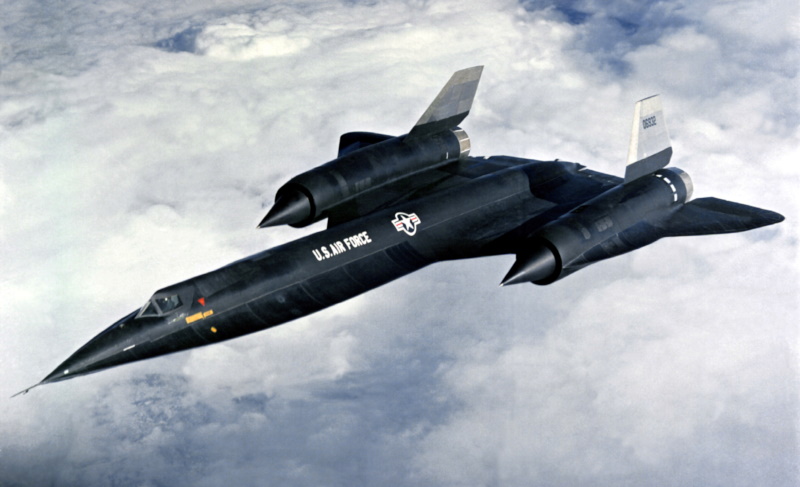
The black paint job -- officially an "indigo blue", but almost everyone called it "black" -- wasn't just to reduce visibility at high altitude, but to improve heat radiation. The A-12 wasn't particularly stealthy in the infrared, but infrared sensing and imaging were in a primitive state in those days. Early in test flights, the A-12s were unpainted, and later were only painted black along their periphery, where heat tended to be concentrated, before they finally went all-black.
Several camera systems were designed for the A-12:
Later, Texas Instruments provided a high-resolution infrared camera. The A-12 never carried anything but camera payloads.
BACK_TO_TOP* As the bugs were being worked out of the A-12, a separate Lockheed team was working on an interceptor variant -- with the company label of "AF-12", later with the service designation of "YF-12A" -- as a follow-on to the canceled North American F-108 Rapier interceptor project. Initial flight was on 7 August 1963, with test pilot Jim Eastham at the controls. Three YF-12As were built, the last being delivered in 1964. They featured:
The radar installation required a new nose and the deletion of the chines forward of the cockpit. These modifications led to yaw instability, and so a fixed ventral fin was attached under the rear of each engine nacelle, with a larger fixed ventral fin attached under the rear fuselage. The centerline ventral fin hydraulically hinged to the right to permit runway clearance. Photos of the YF-12A show it was typically fitted with a spindle-shaped module on a pylon near the front of each engine nacelle; the modules carried flight-test instruments, for example cameras to observe AIM-47 launches.

Kelly Johnson had actually envisioned the A-12 as adaptable to a number of different roles, including nuclear strike. The existence of the YF-12A was finally announced by President Johnson on 29 February 1964. The Republicans were playing the time-honored political card of accusing the Democrats of being "soft on defense", failing to introduce advanced weapons technologies, and Democratic President Johnson wanted to steal their thunder. The president identified it as the "A-11" as a cover designation, leading to some confusion about the type over the years.
A YF-12A was displayed to the public at Edwards Air Force Base (AFB) later in 1964. In May 1965, two YF-12As were used to set a number of records, including a speed record of 3,332.86 KPH (2,070.101 MPH) and an altitude record of 80,257.65 feet (24,668.8 meters). For their speed record flight, pilot Colonel Robert L. Stephens and FCO Lieutenant Colonel Daniel Andre were awarded the 1965 Thompson Trophy. One of three YF-12As was badly damaged in 1966 by a landing mishap that set it on fire; as discussed later, it would fly again, in a different form.
The production "F-12B" was to have had a slimmer nosecone with chines extending to the tip, but it didn't happen, the F-12 program being terminated in early 1968. The AIM-47 missile never entered service, but would lead to the successful AIM-154 Phoenix long-range AAM. NASA obtained the two surviving YF-12As from late 1969 for experimental flights, with the NASA Dryden Center flying them out of Edwards Air Force Base in California.
NASA considered painting them in the agency's standard snappy white / blue colors, but the decision was that it would get dirty and interfere with heat dissipation, so they were left black. They were primarily used for high-speed flight tests. One of the YF-12As was lost in an inflight fire in 1971 -- both crew ejecting safely -- while the other remained in NASA service to 1979, when it was retired to the USAF museum in Dayton, Ohio. It remains there as the sole surviving YF-12A.
BACK_TO_TOP* In operational service, the A-12 was a unique machine, requiring the most highly trained pilots. The operational pilots were acquired from the Air Force, having been "sheepdipped", resigning from the USAF to fly as civilians. At Mach 3, the A-12 was inclined to the dangerously unstable, being intolerant of maneuvering -- but it was intended to fly in straight lines, or shallow curves, and so that was not generally a major problem. At cruise speed stick forces were very high, though at such speeds it flew on autopilot. Pilots regarded it as literally awesome.
It would take about a hundred ground crew at least a day to prep an A-12 for a mission. Take-offs of an A-12 were extremely noisy, described as "tearing the sky apart". Full afterburner would generate long blowtorch streams of blue and orange flames, with the noise becoming skull-shaking.
In the meantime, the US Air Force was obtaining their own derivative of the A-12, in the form of the "SR-71" -- discussed in the next chapter. The long delays and problems with the A-12 OXCART program left the CIA vulnerable to Air Force lobbying. The agency became increasingly desperate to fly an A-12 mission to help keep the program afloat, but proposals were repeatedly turned down. Finally, in the spring of 1967, the go-ahead was given to use A-12s to overfly North Vietnam and hunt for tactical ballistic missiles (TBM) that the North Vietnamese were supposed to have obtained.
The exercise was codenamed BLACK SHIELD. Three A-12s were deployed to Kadena, along with support personnel and equipment. The initial mission was on 31 May 1967, with pilot Mele Vojvodich roaring off from Kadena with "orange balls coming out the rear of the aircraft", as one witness described it. Vojvodich penetrated North Vietnamese airspace, was blessed with clear weather, and took an excellent set of photographs. He landed back at Kadena in the pouring rain a little over three and a half hours after departure.
By mid-July, coverage of North Vietnam was thorough enough to rule out the presence of TBMs. Missions were flown over Southeast Asia on a regular basis through the rest of the year. The North Vietnamese fired SA-2 surface-to-air missiles (SAM) at the A-12s every time they intruded into North Vietnamese airspace. On 30 October, an A-12 pilot named Denny Sullivan counted the detonation of at least eight SA-2s; the aircraft was actually hit by a little fragment that did no serious damage. That was about as close to shooting down an A-12 / SR-71 as anyone would ever get. 22 operational A-12 missions were flown in 1967.
* The success of BLACK SHIELD helped the CIA put the OXCART program back on a more level footing, though the political rivalry between the agency's A-12 and the Air Force's SR-71 persisted. A competitive flyoff between the A-12 and SR-71, codenamed NICE GIRL, was performed in 1967 -- but the Johnson Administration continued to waffle, supporting both the A-12 and SR-71 for the moment. The BLACK SHIELD overflights continued into early 1968, with six operational flights performed, including four over North Vietnam, and two over North Korea.
On 23 January 1968, the North Koreans had seized the US Navy SIGINT ship PUEBLO in international waters; there were fears that this was a step towards full-scale war. On 26 January, CIA pilot Frank Murray took an A-12 on an overflight of North Korea in hopes of locating the PUEBLO, determine the mobilization status of the North Korean military, and demonstrate a degree of assertiveness. Murray said later:
BEGIN_QUOTE:
I left Kadena, topped-off, then entered northern airspace over the Sea of Japan via the Korean Straits. My first pass started off near Vladivostok, then with the camera on, I flew down the east coast of North Korea, where we thought the boat was. As I approached Wonsan, I could see the PUEBLO through my view sight. The harbor was all iced up, except at the very entrance -- and there she was, sitting off to the right of the main entrance.
I continued to the border with South Korea, made a 180-degree turn, and flew back over North Korea. I made four passes, photographing the whole of North Korea from the DMZ to the Yalu border. As far as I knew, I was undetected throughout the flight -- but when I got back to Kadena, some folks told me that the Chinese had detected me and told the North Koreans, but they never reacted.
END_QUOTE
The lack of response was likely because the North Koreans couldn't fire on an aircraft that they couldn't even track. Another overflight was performed on 19 February 1968, followed by a third on 8 May. There were no signs of any serious mobilization for war.
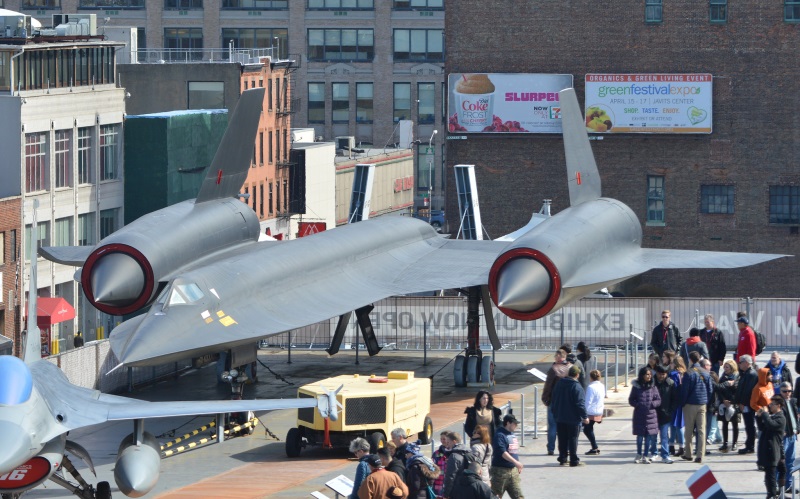
The 8 May flight was the last operational mission of the A-12. On 16 May 1968, after a long debate in the halls of power, US Defense Secretary Clark Clifford ordered the A-12 program to be shut down. It had only spent a year in operational service. By mid-June, the BLACK SHIELD operation from Kadena had transitioned from a CIA A-12 program to a USAF SR-71 program. Incidentally, although the Air Force never flew the A-12, there are photos of them with USAF markings, presumably as a cover. The last flight of the A-12 was on 28 June 1968, with Frank Layton at the controls. OXCART was dead; long live Blackbird. A number of the surviving A-12s ended up as museum displays.
BACK_TO_TOP